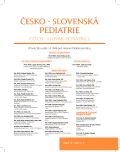Histamine intolerance in childhood – case reports from clinical praxis
Authors:
M. Kohútová; M. Jeseňák
; Ľ. Jakušová; L. Šofranková; O. Petrovičová; L. Vávrová 1; Peter Bánovčin
Authors‘ workplace:
Klinika detí a dorastu, Univerzitná nemocnica Martin, Jesseniova lekárska fakulta v Martine
Univerzita Komenského v Bratislave
; Oddelenie lekárskej genetiky, Onkologický ústav sv. Alžbety n. o., Bratislava
1
Published in:
Čes-slov Pediat 2017; 72 (5): 314-321.
Category:
Case Report
Overview
Histamine intolerance (hereinafter referred to as HIT) is a disease which belongs to food intolerance disorders. Only several studies aimed at histamine intolerance research have been carried out in paediatric environment. Reasons behind the development of HIT may be an excessive accumulation of histamine in organism and a disorder of metabolic degradation of histamine. The clinical picture of HIT consists of several non-specific signs and symptoms which are often similar to allergic reactions. HIT poses a diagnostic problem, as an effective diagnostic tool for HIT is unavailable. A frequently used clinical method is to determine activity and concentration of diamine oxidase (DAO) in serum and in biopsy sample from intestinal epithelium. It is also possible to apply molecular genetics examination of polymorphisms in gene for DAO. However, the stated types of examination function as additional information only, as they do not lead to confirmation or exclusion of the disease. Clinical diagnosis is usually determined by a positive response of patients to low histamine diet and by an extensive diagnostical exclusion of other diseases.
KEY WORDS:
histamine intolerance, infants, diamine oxidase, DAO, molecular genetics examination, low histamine diet
Sources
1. Mušič M, Korošec P, Šilar M, et al. Serum diamine oxidase activity as a diagnostic test for histamine intolerance. Wien Klin Wochenschr 2013; 125 (9–10): 239–243.
2. Kofler L, Ulmer H, Kofler H. Histamine 50-Skin-Prick Test: A tool to diagnose histamine intolerance. ISRN Allergy 2011; (2011): Article ID 353045 : 1–5.
3. Maintz L, Schwarzer V, Bieber T, et al. Effects of histamine and diamine oxidase activities on pregnancy: a critical review. Hum Reprod Update 2008; 14 (5): 485–495.
4. Rosell-Camps A, Zibetti S, Peréz-Esteban G, et al. Histamine intolerance as a cause of chronic digestive complaints in pediatric patients. Rev Esp Enferm Dig 2013; 105 (4): 201–207.
5. Ivkovič-Jurekovič E. Idiopathic anaphylaxis and histamine intolerance. Pediatr Allergy Immunol 2015; 26 (7): 685–687.
6. Smolinska S, Jutel M, Crameri R, et al. Histamine and gut mucosal immune regulation. Allergy 2014; 69 (3): 273–281.
7. Reese I, Ballmer-Weber B, Beyer K, et al. Vorgehen bei Verdacht auf Unverträglichkeit gegenüber oral aufgenommenem Histamin. Allergo Journal 2017, 26 (2): 51–61.
8. Maintz L, Yu CF, Rodríguez E, et al. Association of single nucleotide polymorphisms in the diamine oxidasegene with diamine oxidase serum activities. Allergy 2011; 66 (7): 893–902.
9. Maintz L, Novak N. Histamine and histamine intolerance. Am J Clin Nutr 2007; 85 (5): 1185–1196.
10. Chung BY, Cho SI, Ahn IS, et al. Treatment of atopic dermatitis with a low-histamine diet. Ann Dermatol 2011; 23 (Suppl 1): S91–S95.
11. Kofler H. Histaminunverträglichkeit. Hautnah 2014; 13 (1): 13–15.
12. Hrubiško M. Histamínová intolerancia. Známa neznáma. Teva – Sciotec, 2011 : 1–26.
13. Fuchs M, Švarcová I, Macková L, et al. Histaminová intolerance, snížená aktivita diaminooxidázy. Alergie 2011; 13 (3): 229–233.
14. Jakušová Ľ, Havlíčeková Z, Šofranková L, et al. Laktózová intolerancia – I. časť. Pediatria 2013; 8 (1): 24–28.
15. Jakušová Ľ, Havlíčeková Z, Šofranková L, et al. Laktózová intolerancia – II. časť. Pediatria 2013; 8 (4): 195–199.
16. Maintz L, Bieber T, Novak N. Histamine intolerance in clinical practice. Dtsch Arztebl 2006; 103 (51–52): 3477–3483.
17. Havlíčeková Z, Szepéová R, Jeseňák M, et al. Histamínová intolerancia. Gastroenterol prax 2012; 11 (4): 194–196.
Labels
Neonatology Paediatrics General practitioner for children and adolescentsArticle was published in
Czech-Slovak Pediatrics

2017 Issue 5
- What Effect Can Be Expected from Limosilactobacillus reuteri in Mucositis and Peri-Implantitis?
- The Importance of Limosilactobacillus reuteri in Administration to Diabetics with Gingivitis
Most read in this issue
- Histamine intolerance in childhood – case reports from clinical praxis
- Enteral nutrition in the treatment of inflammatory bowel disease
- Correction of congenital breast and chest wall malformations by lipomodelling technique
- Perianal lesions – condylomata or Crohn’s disease?
